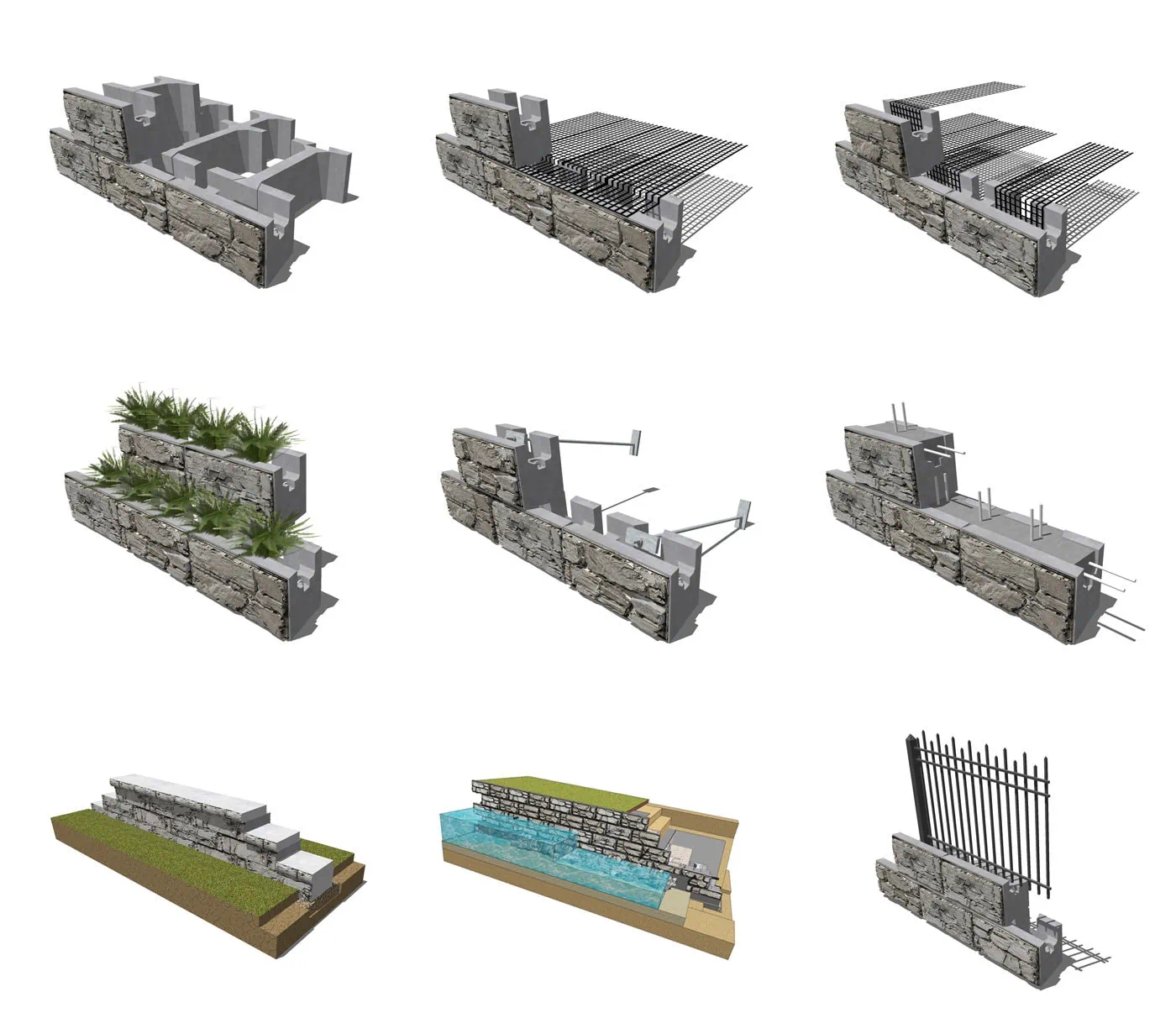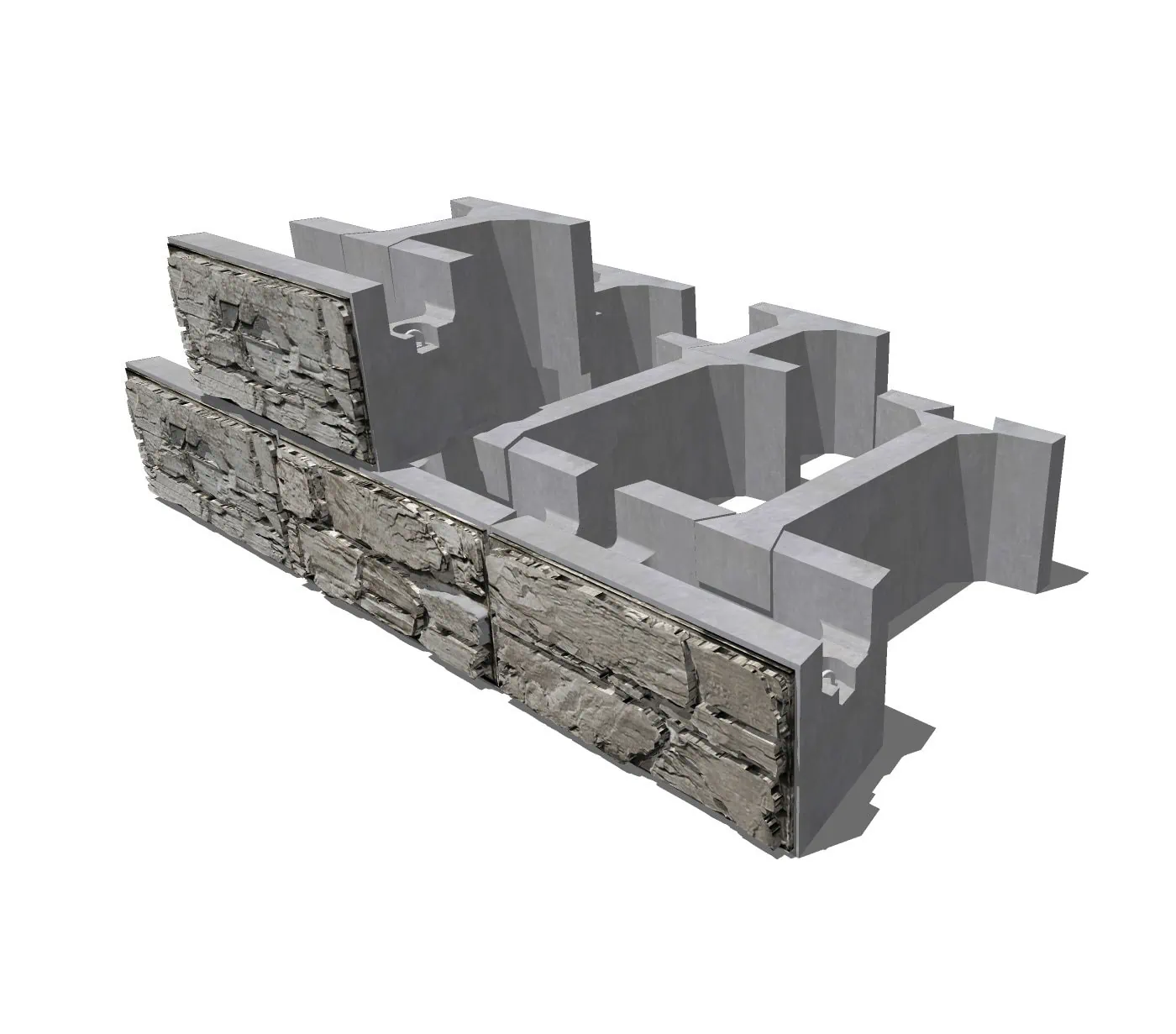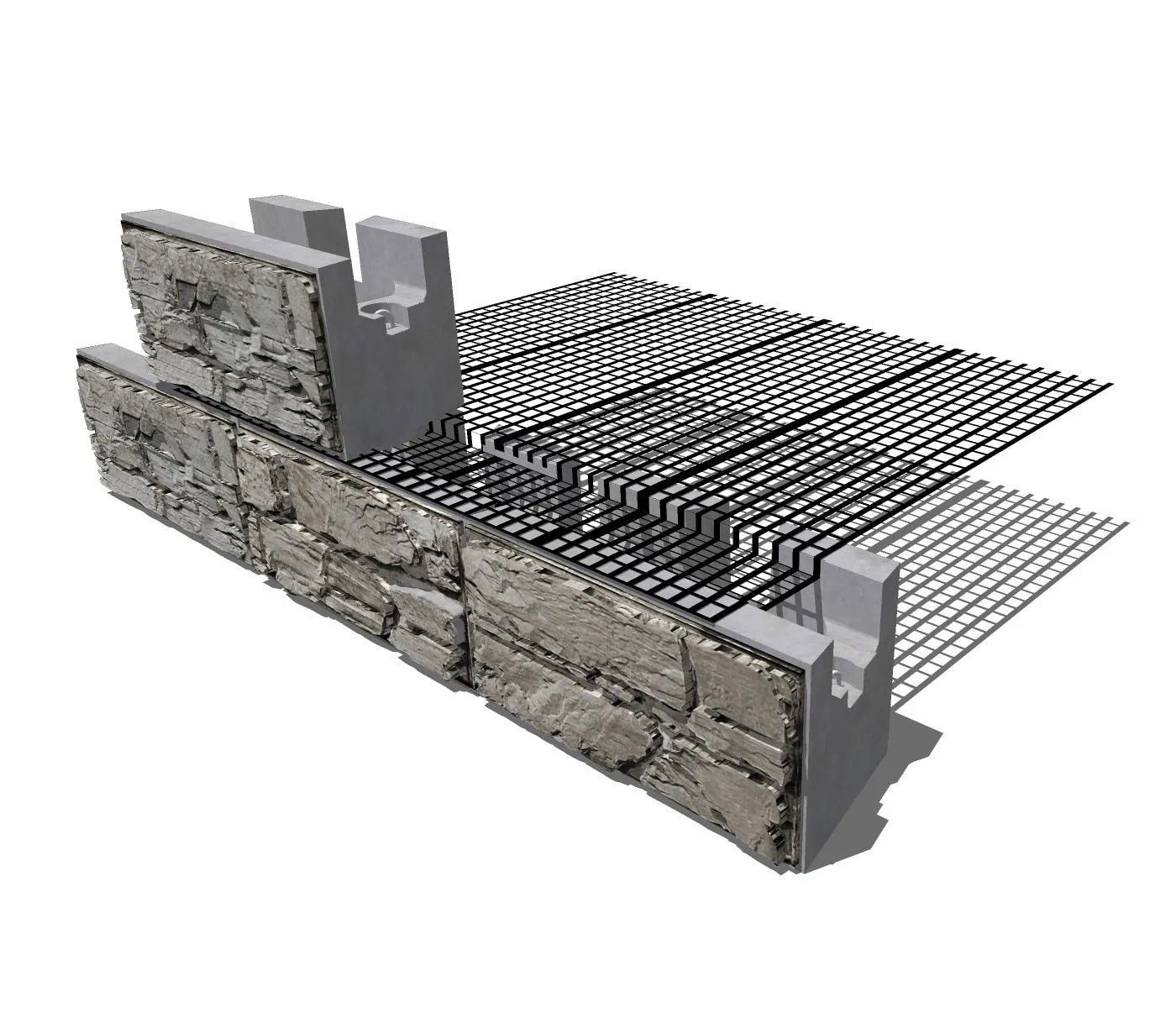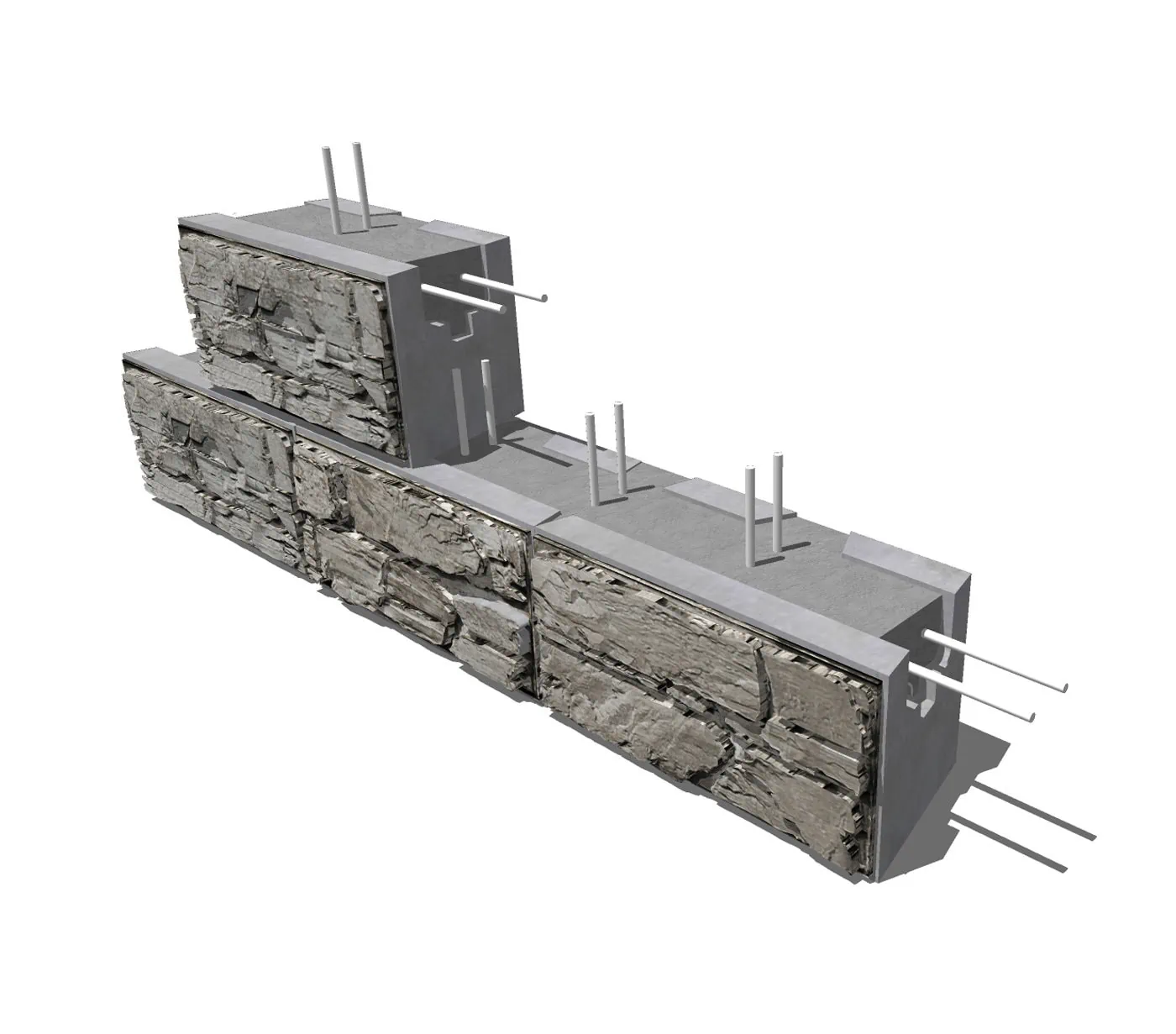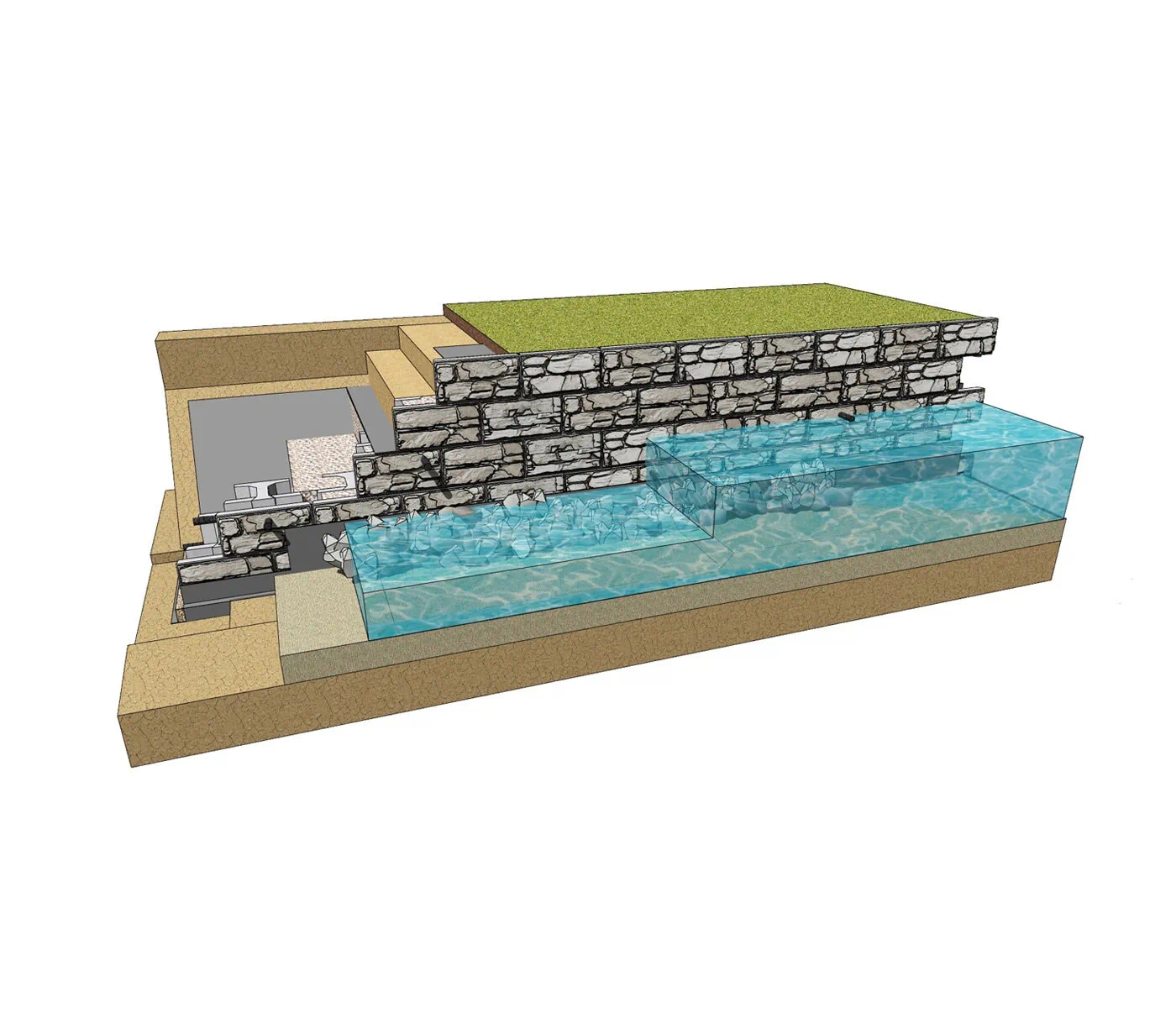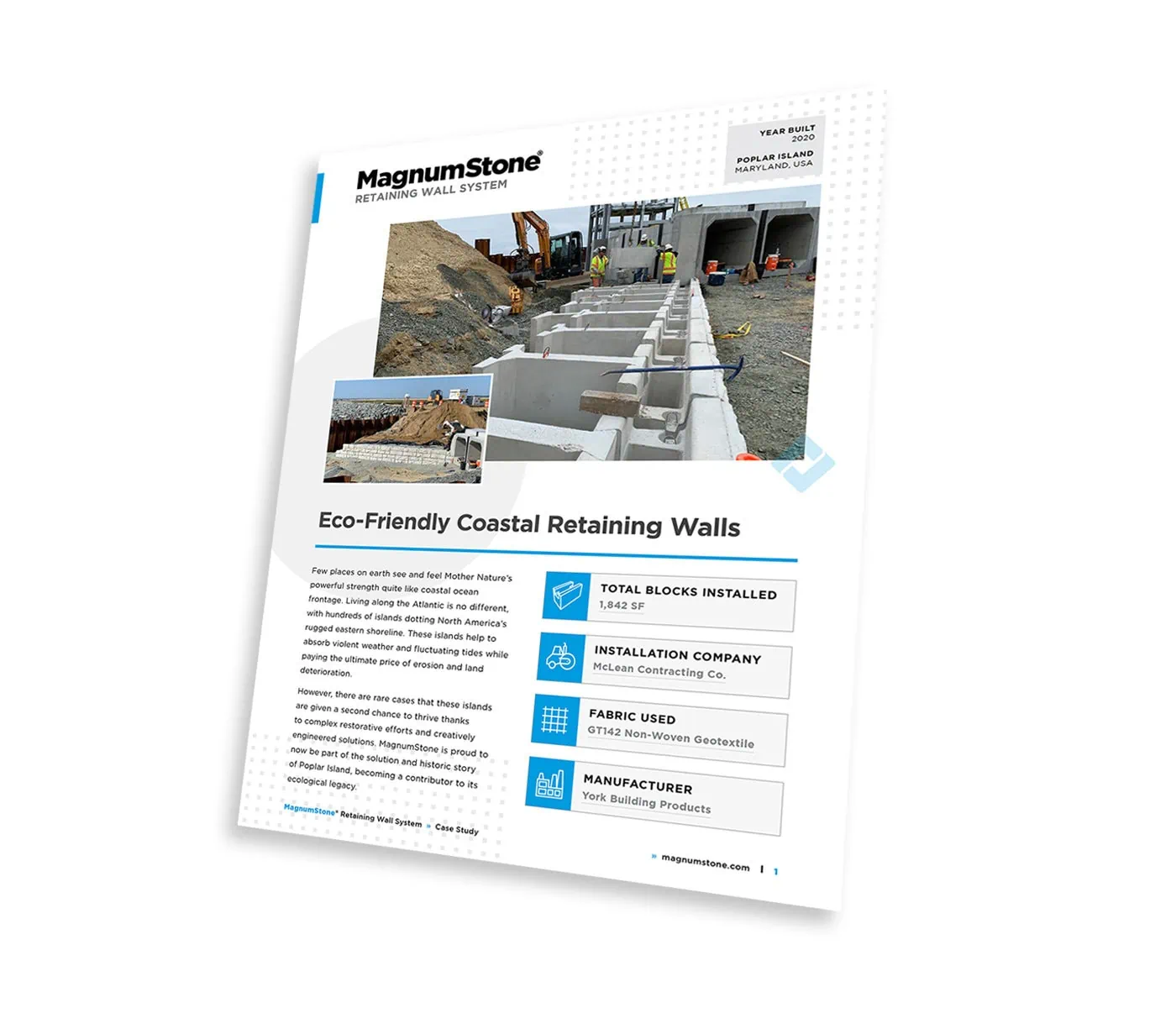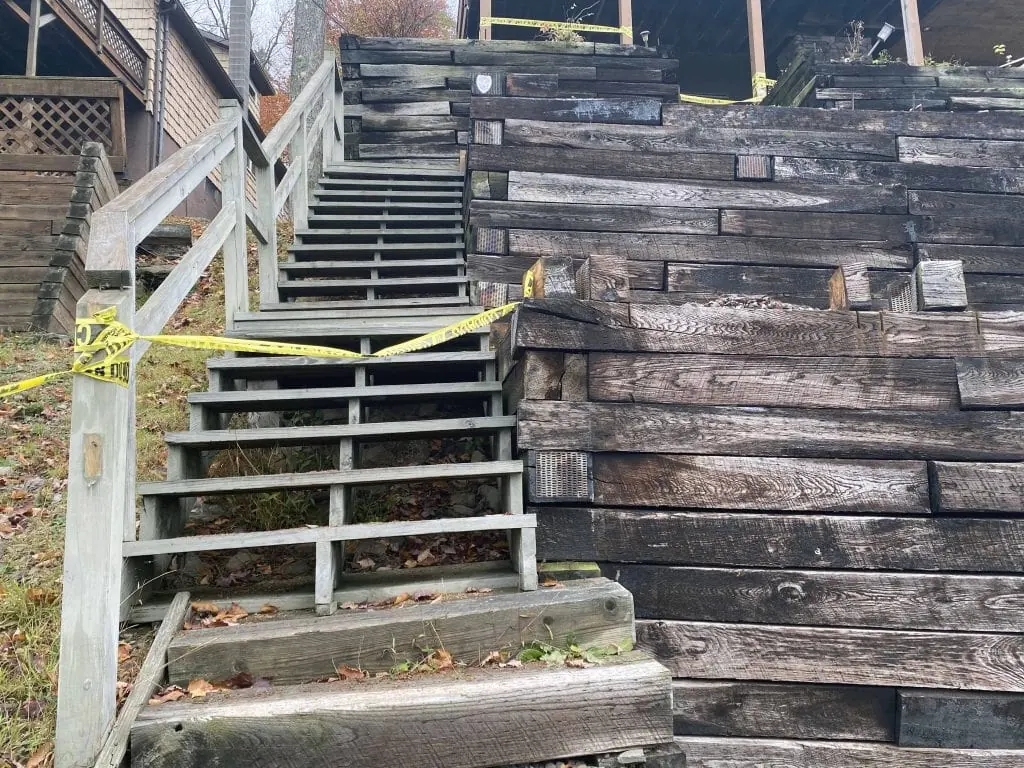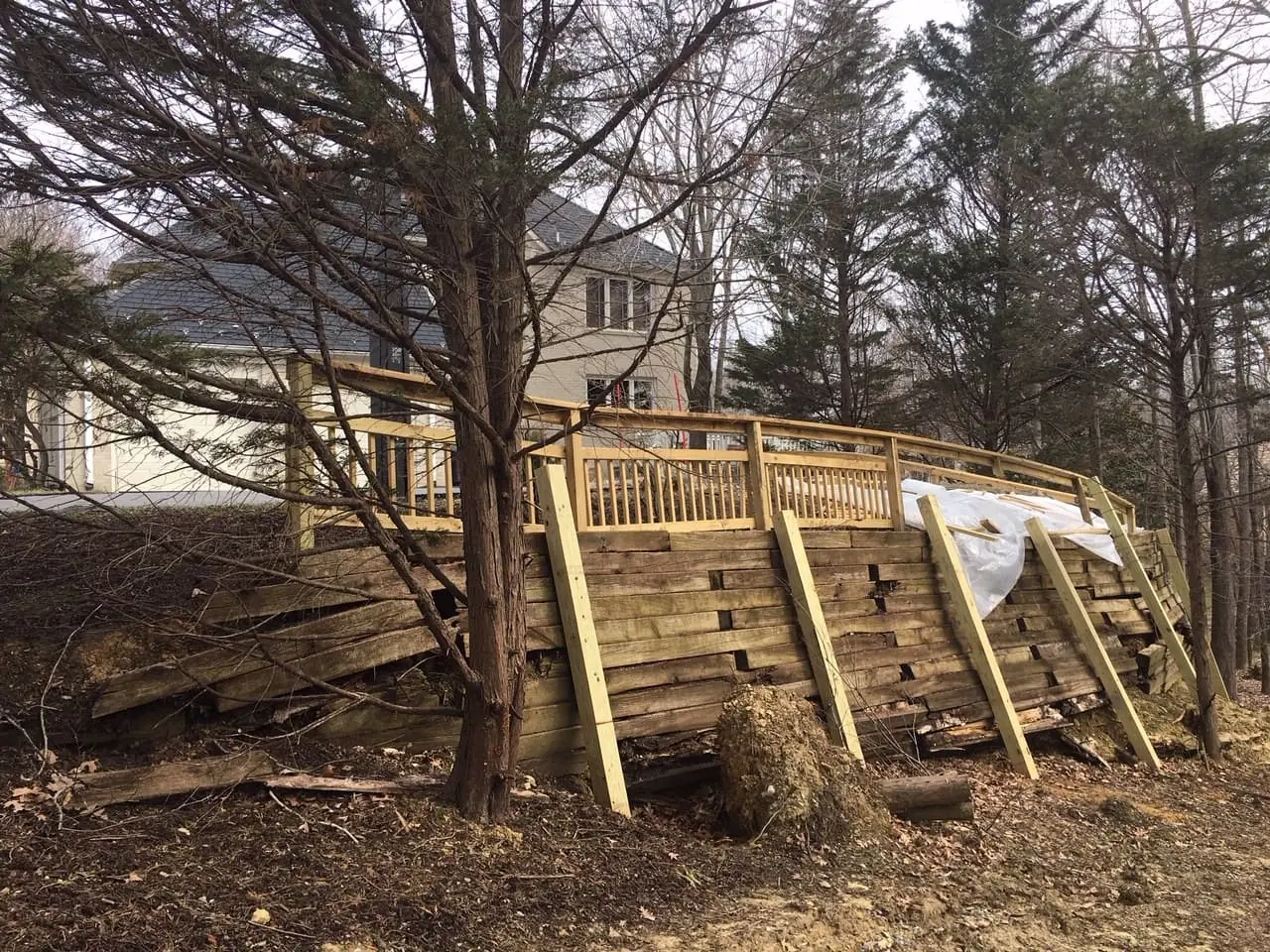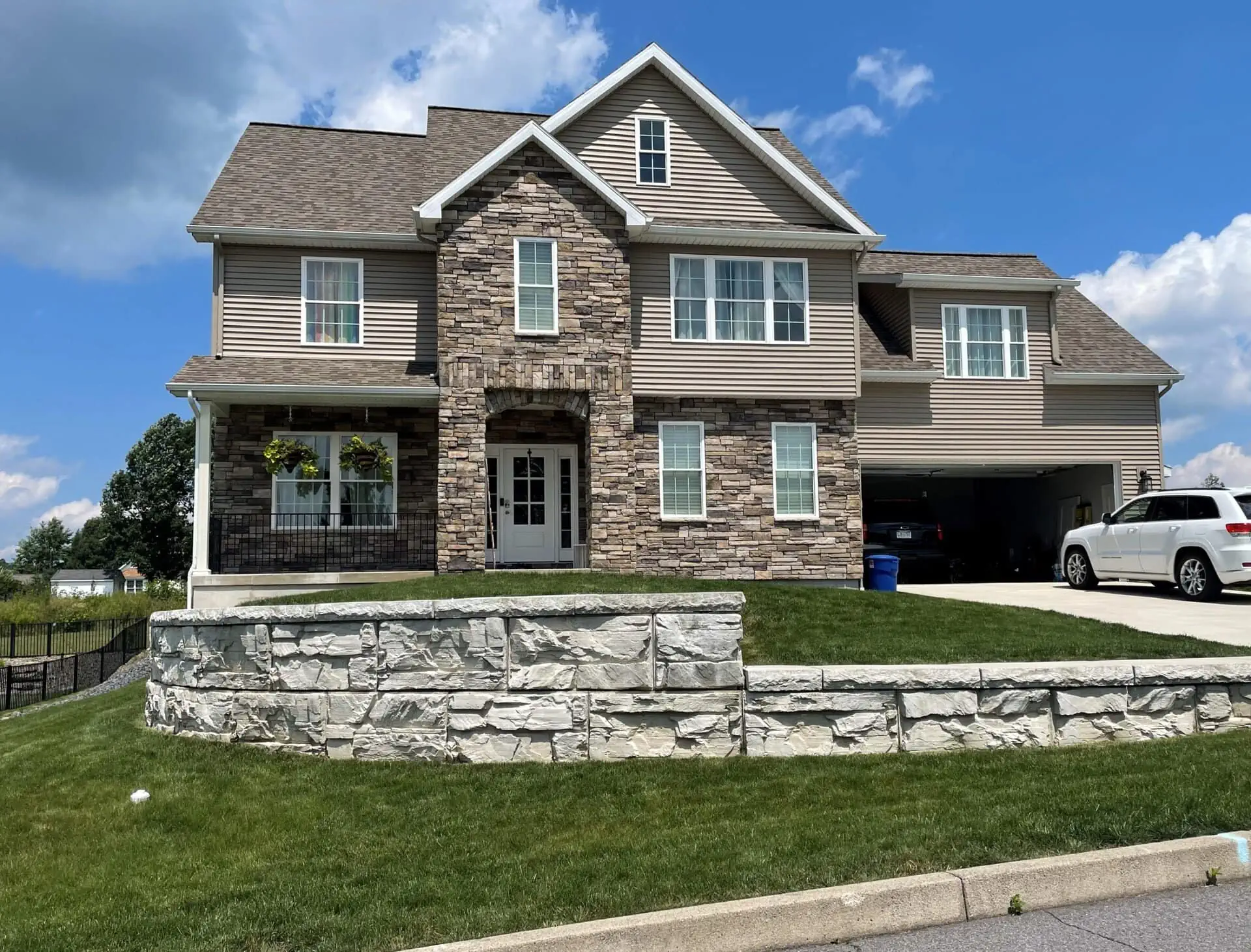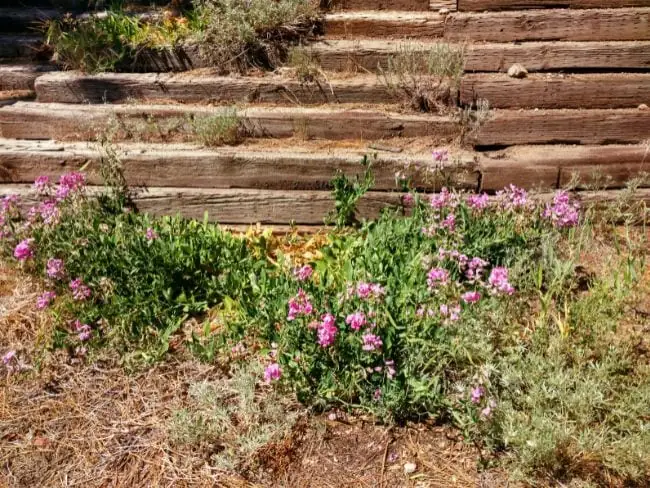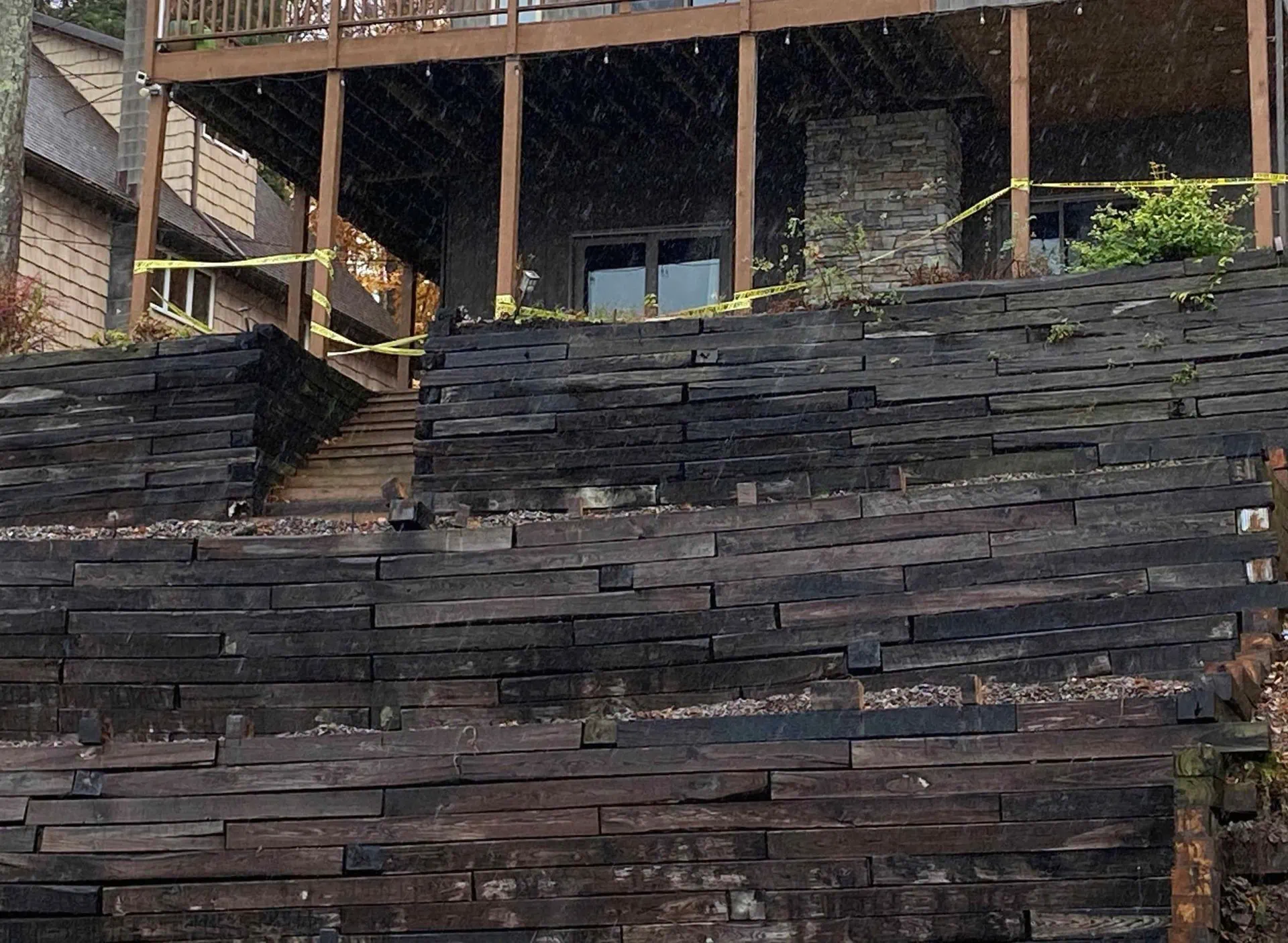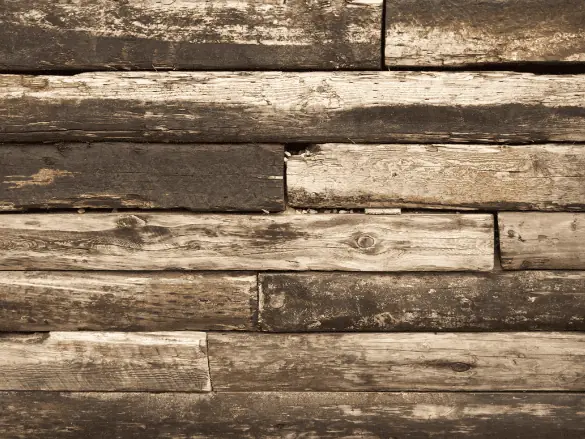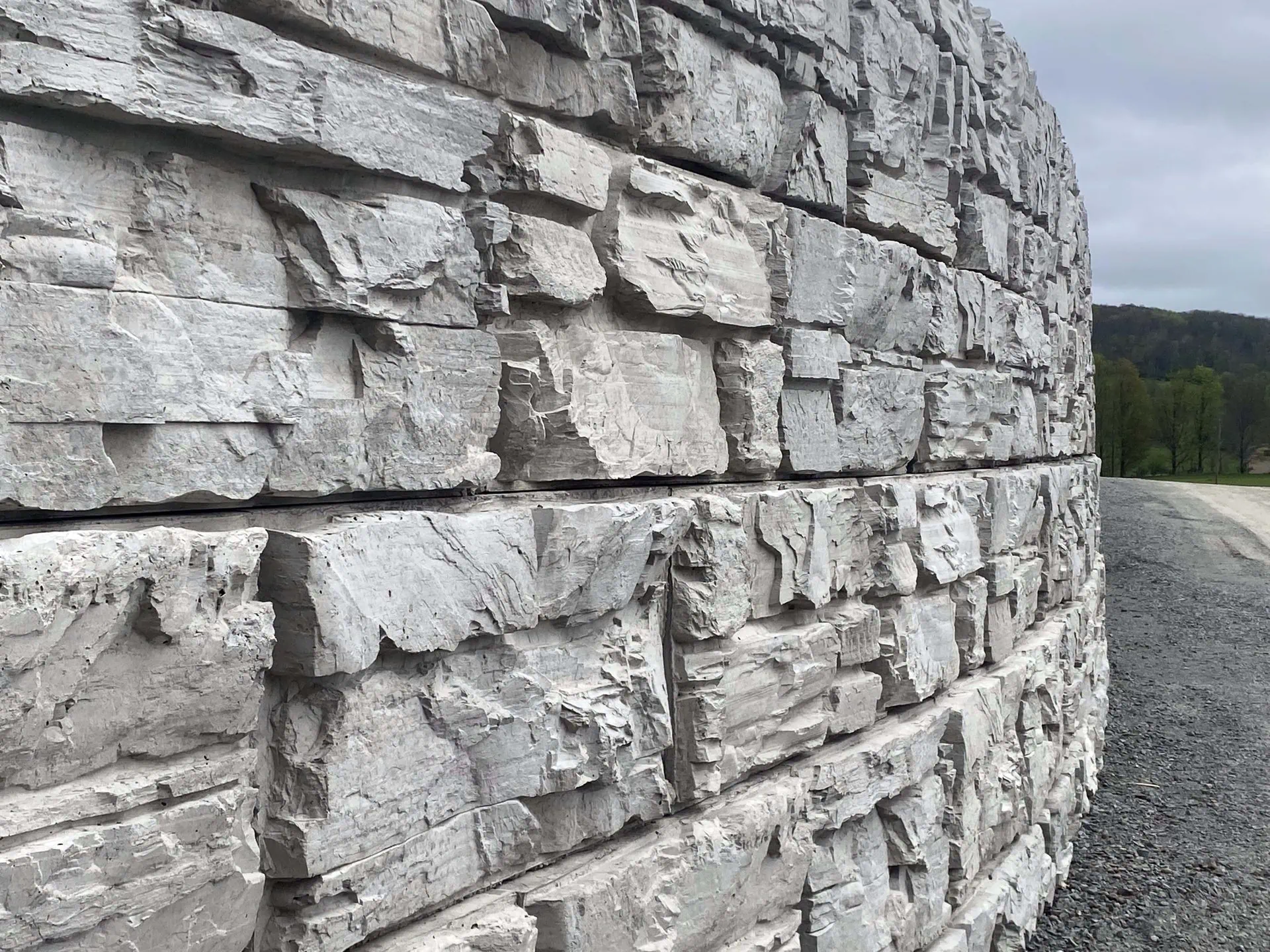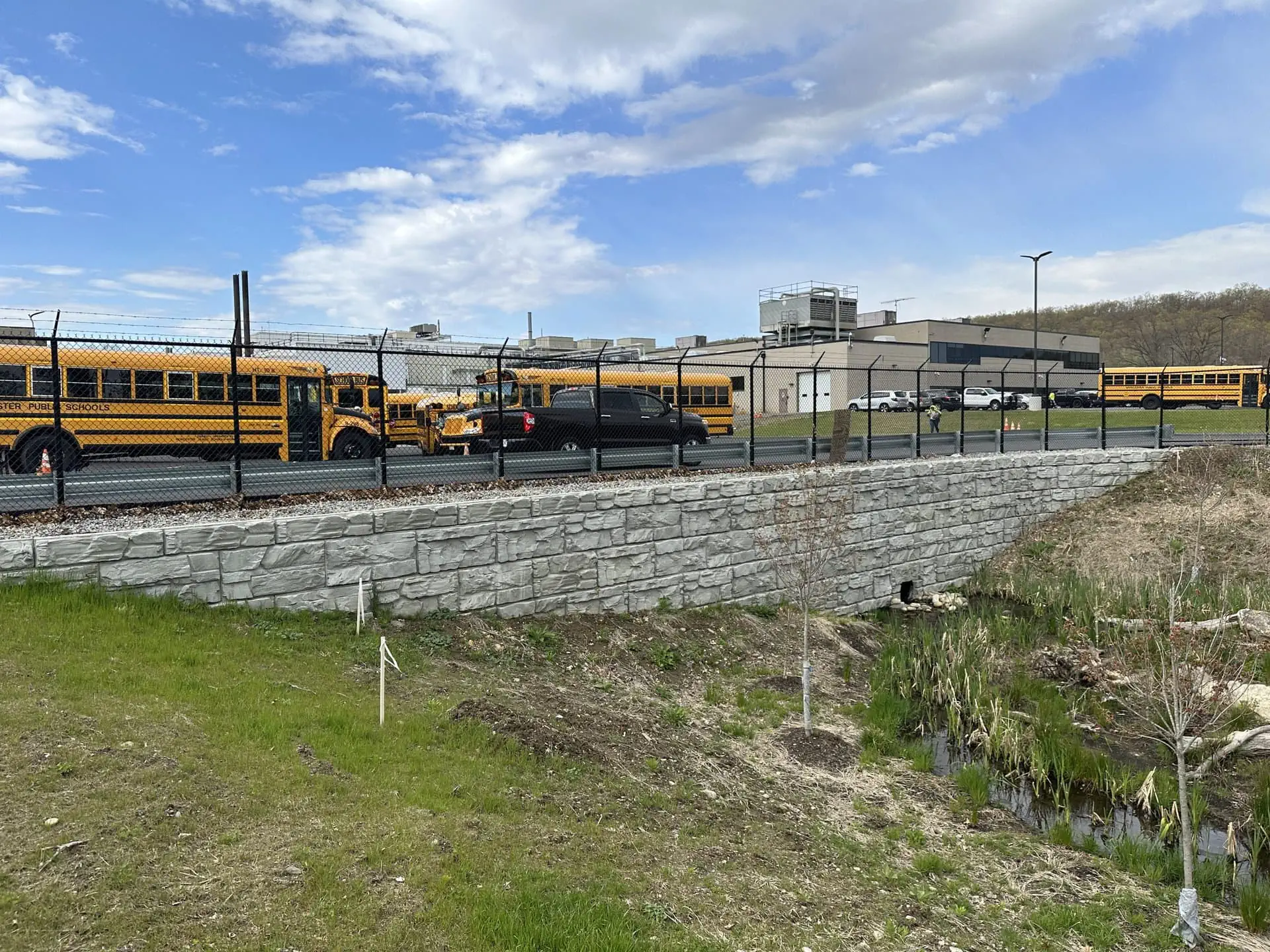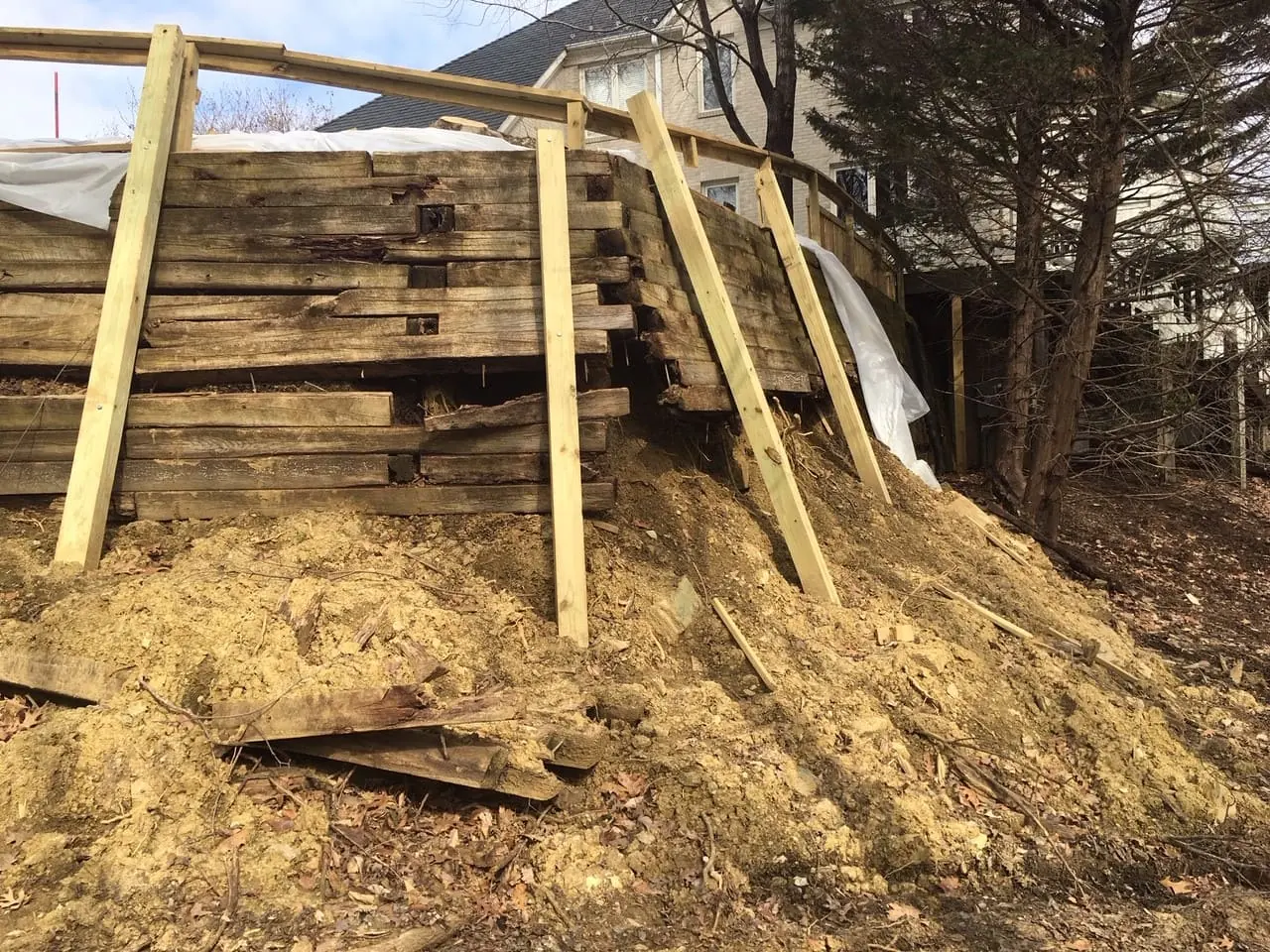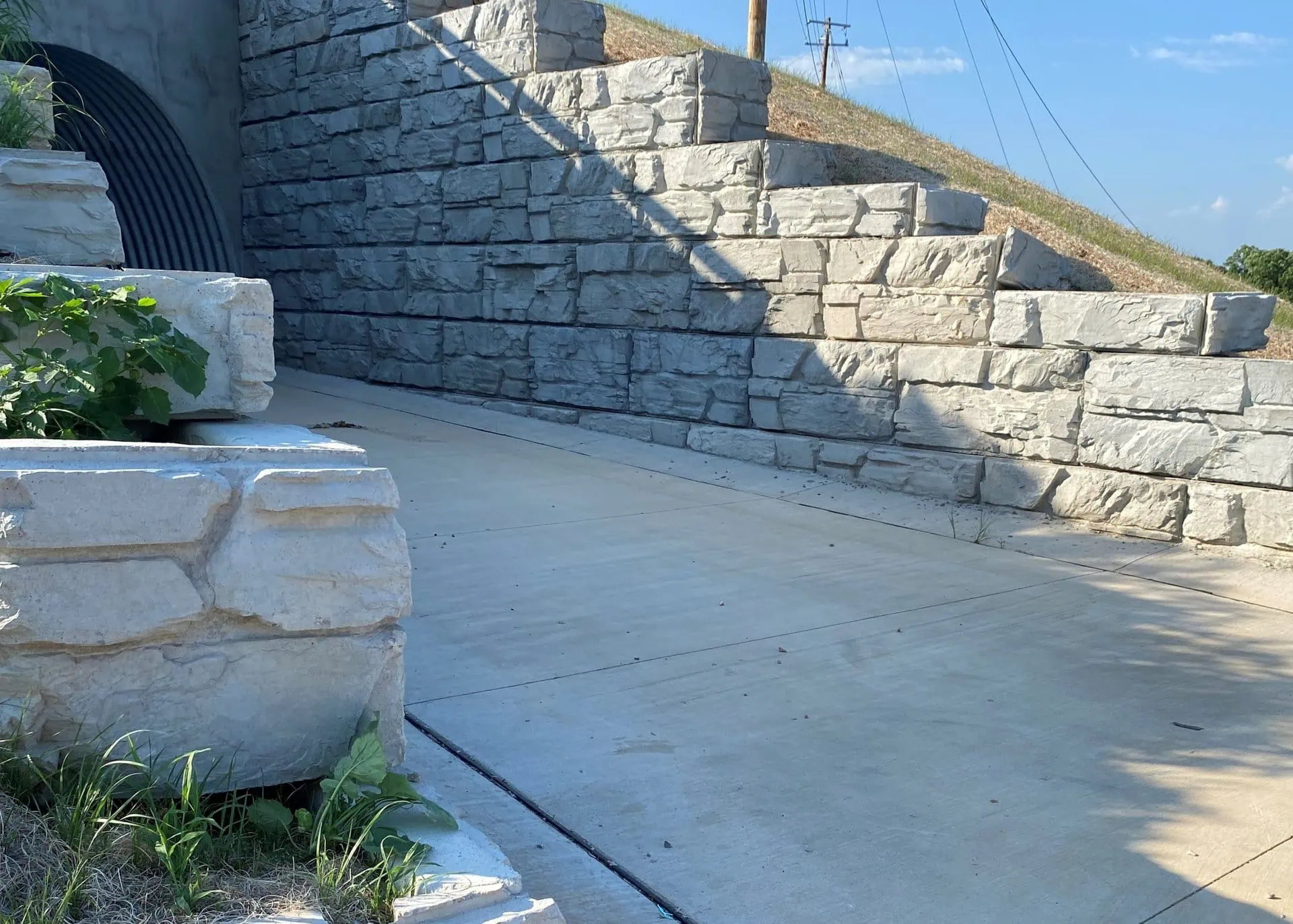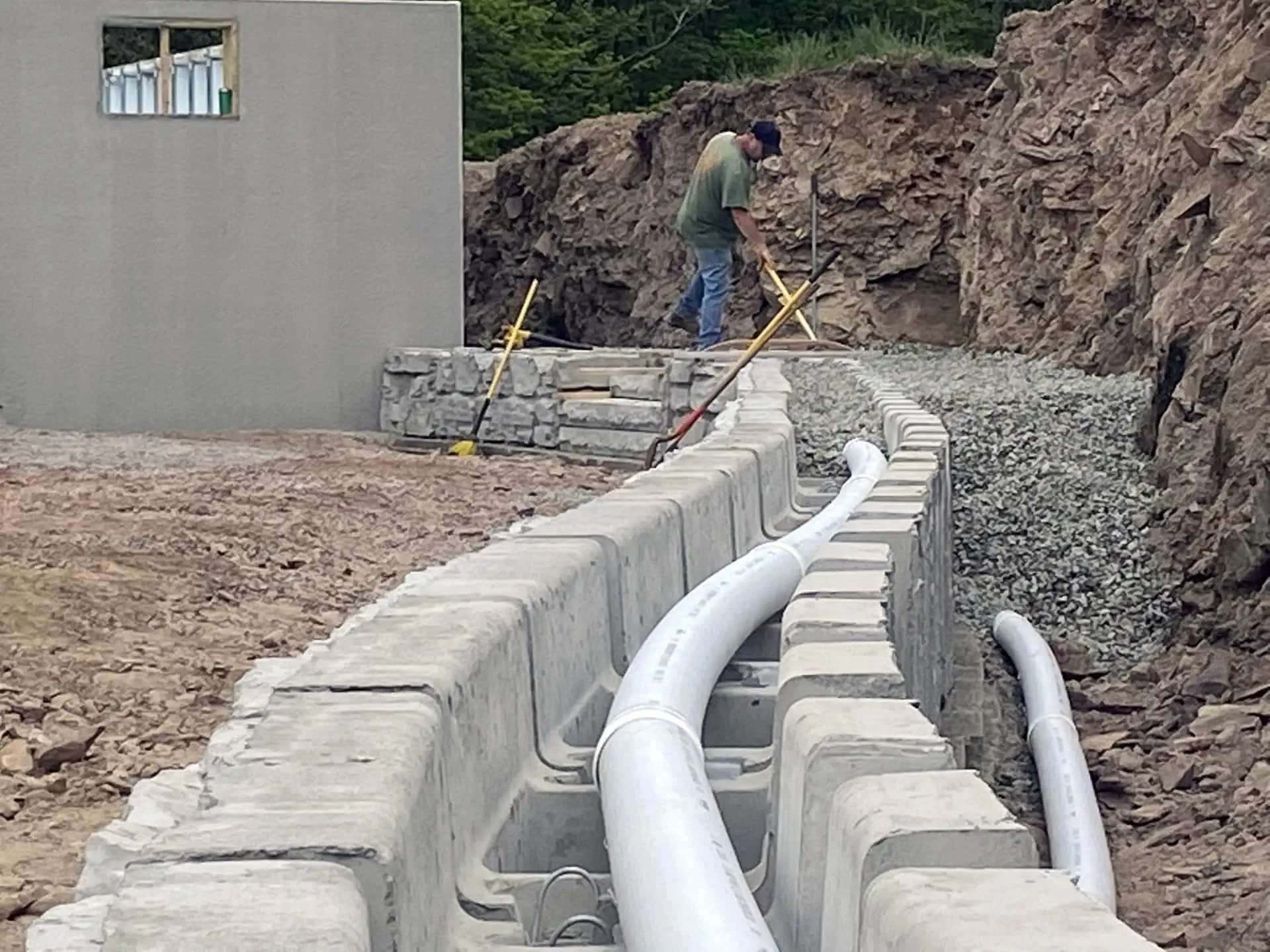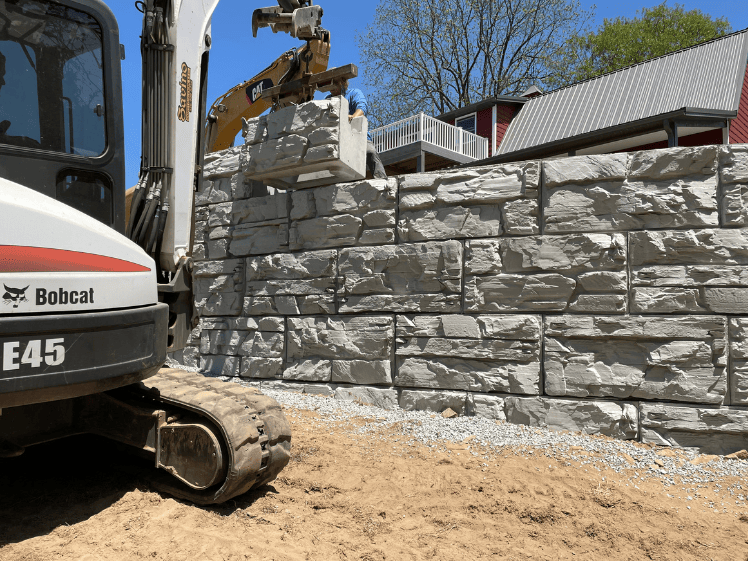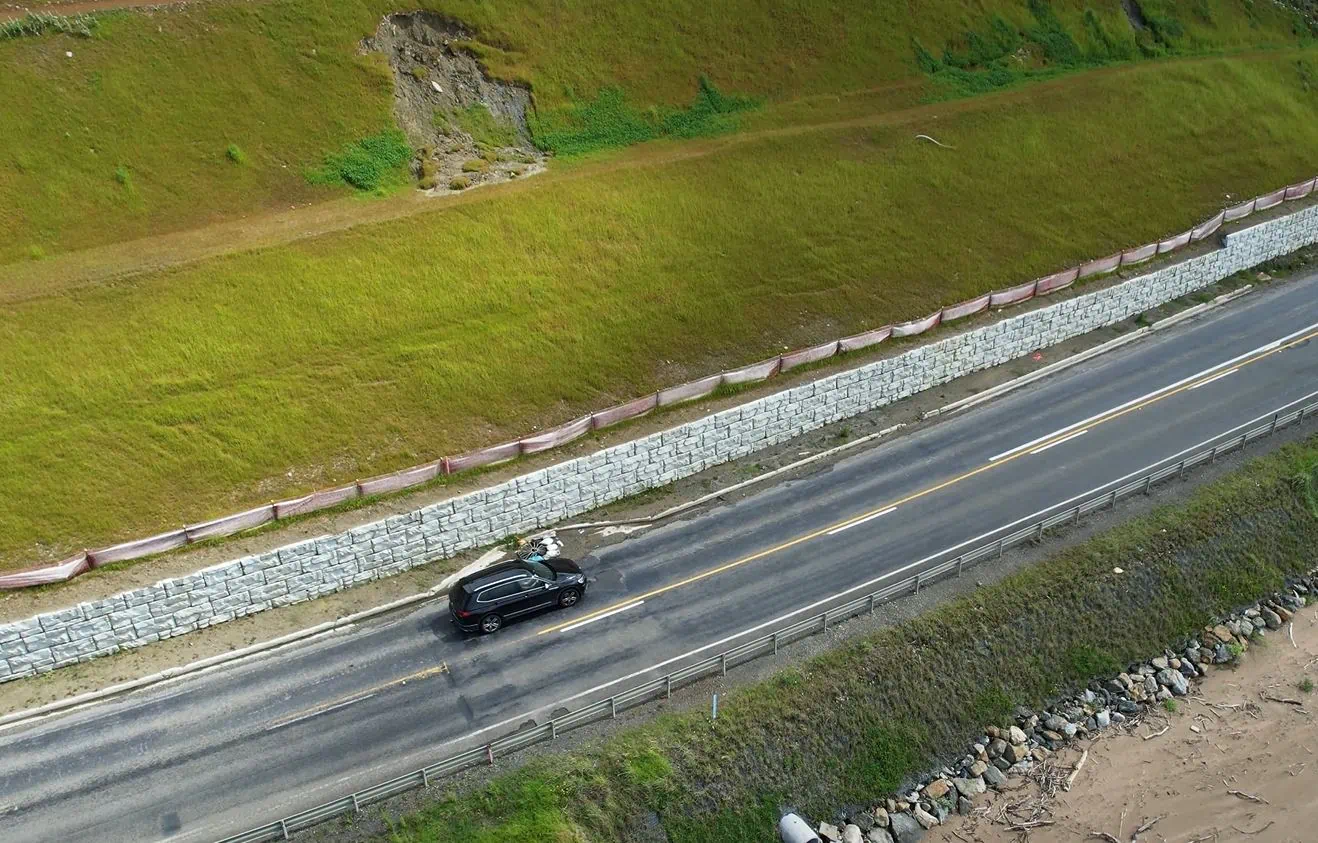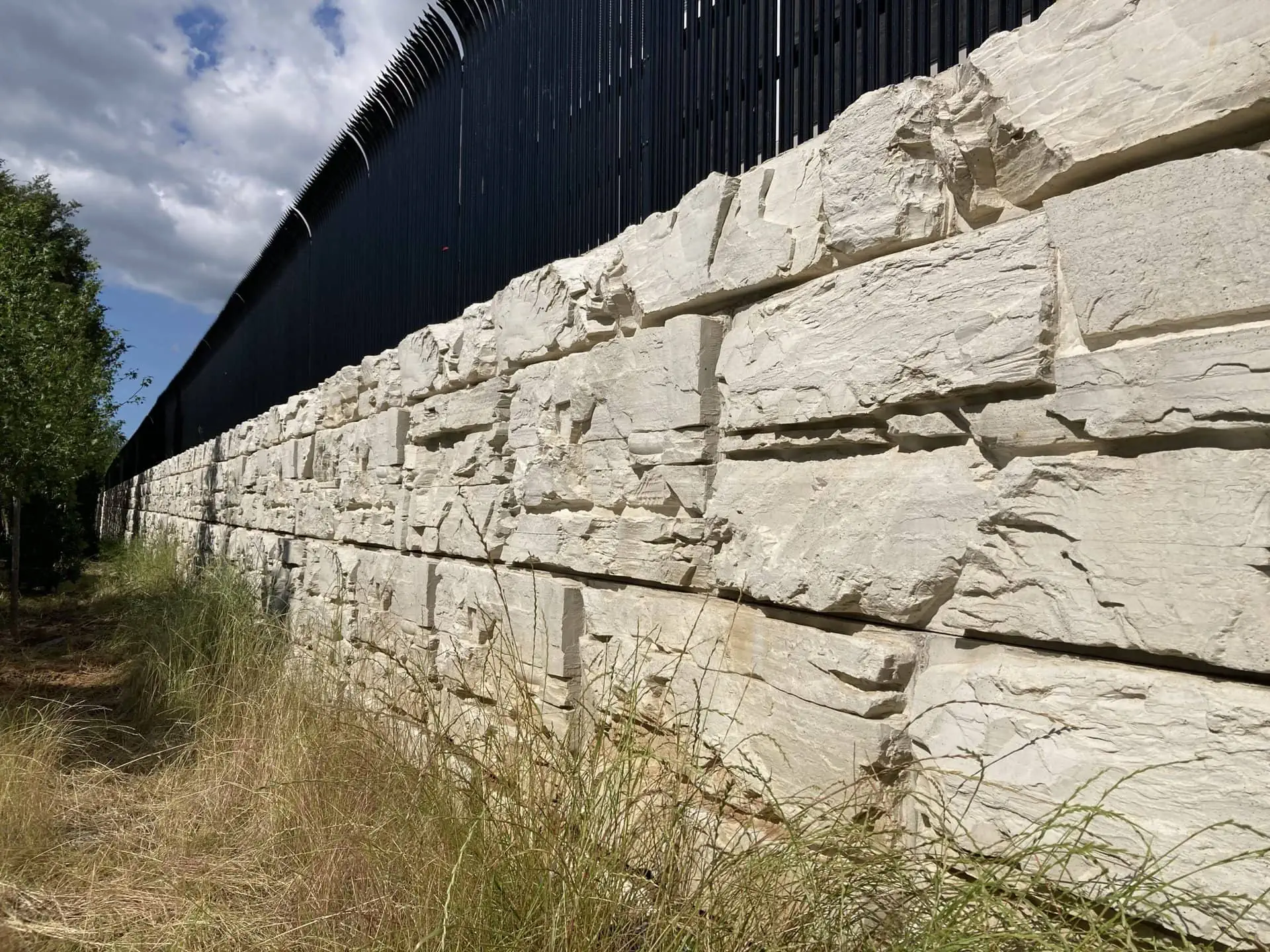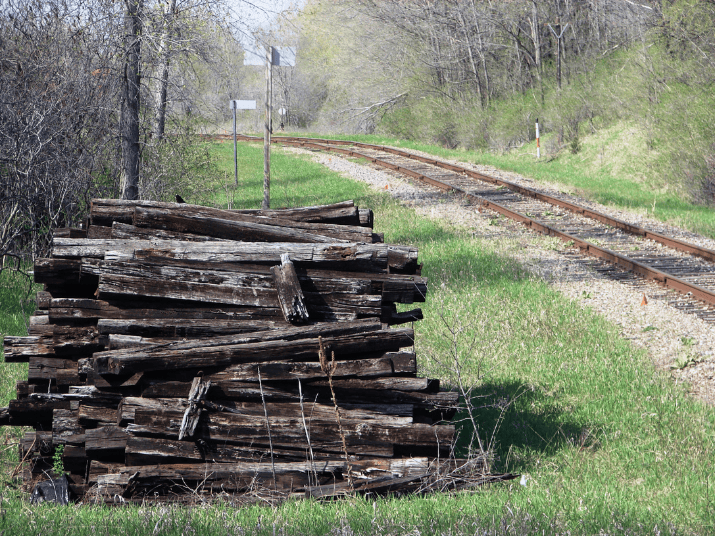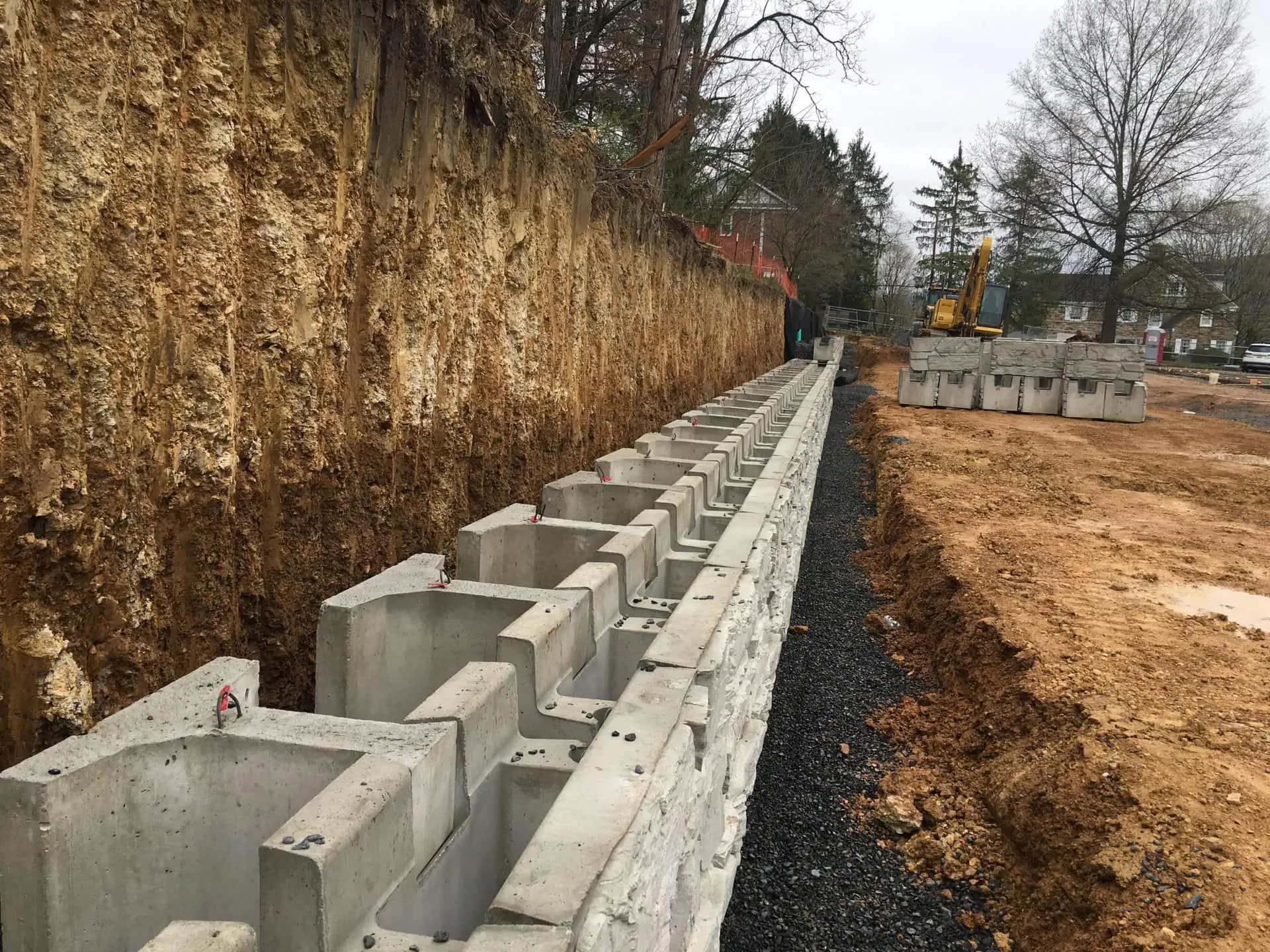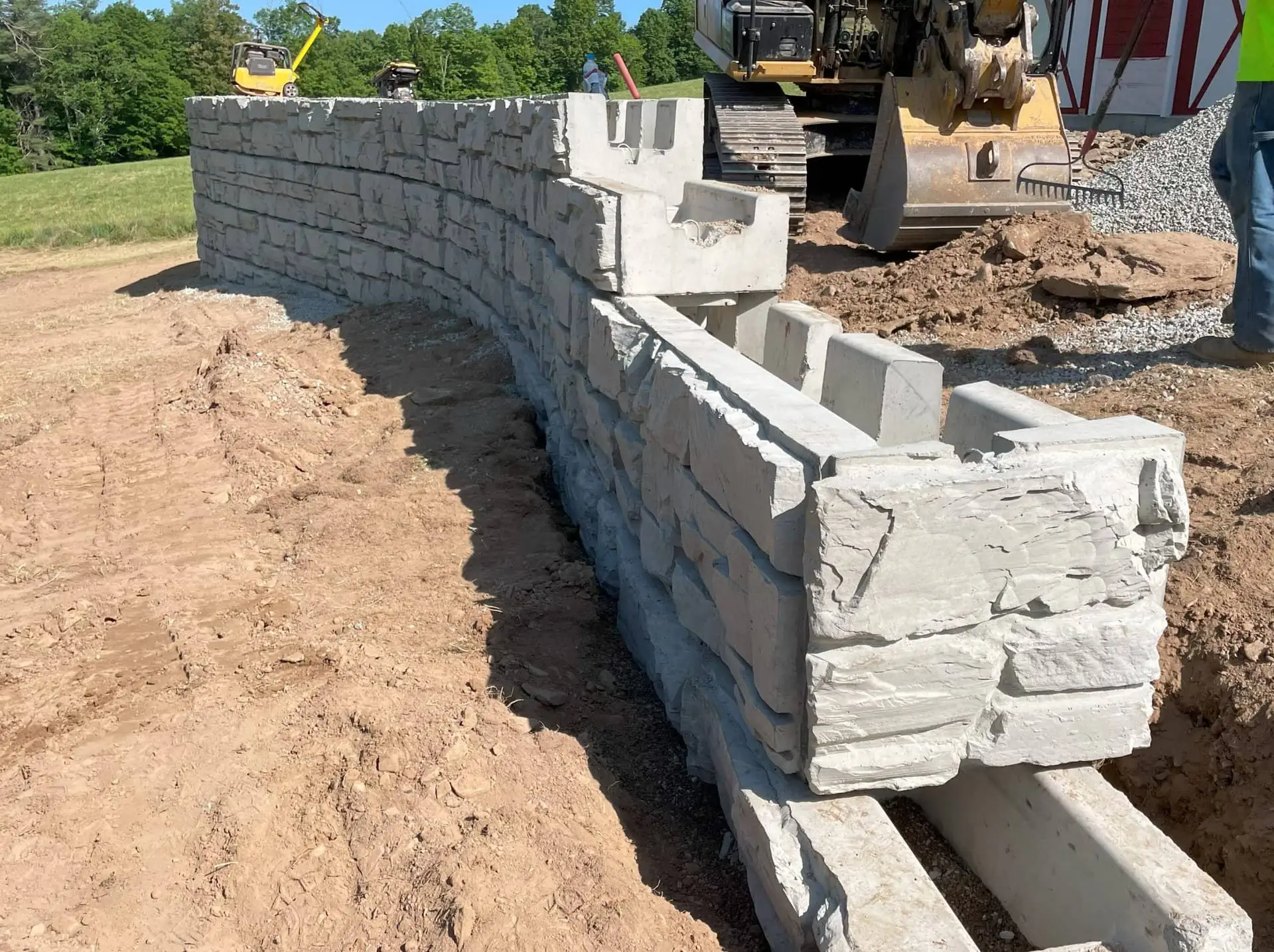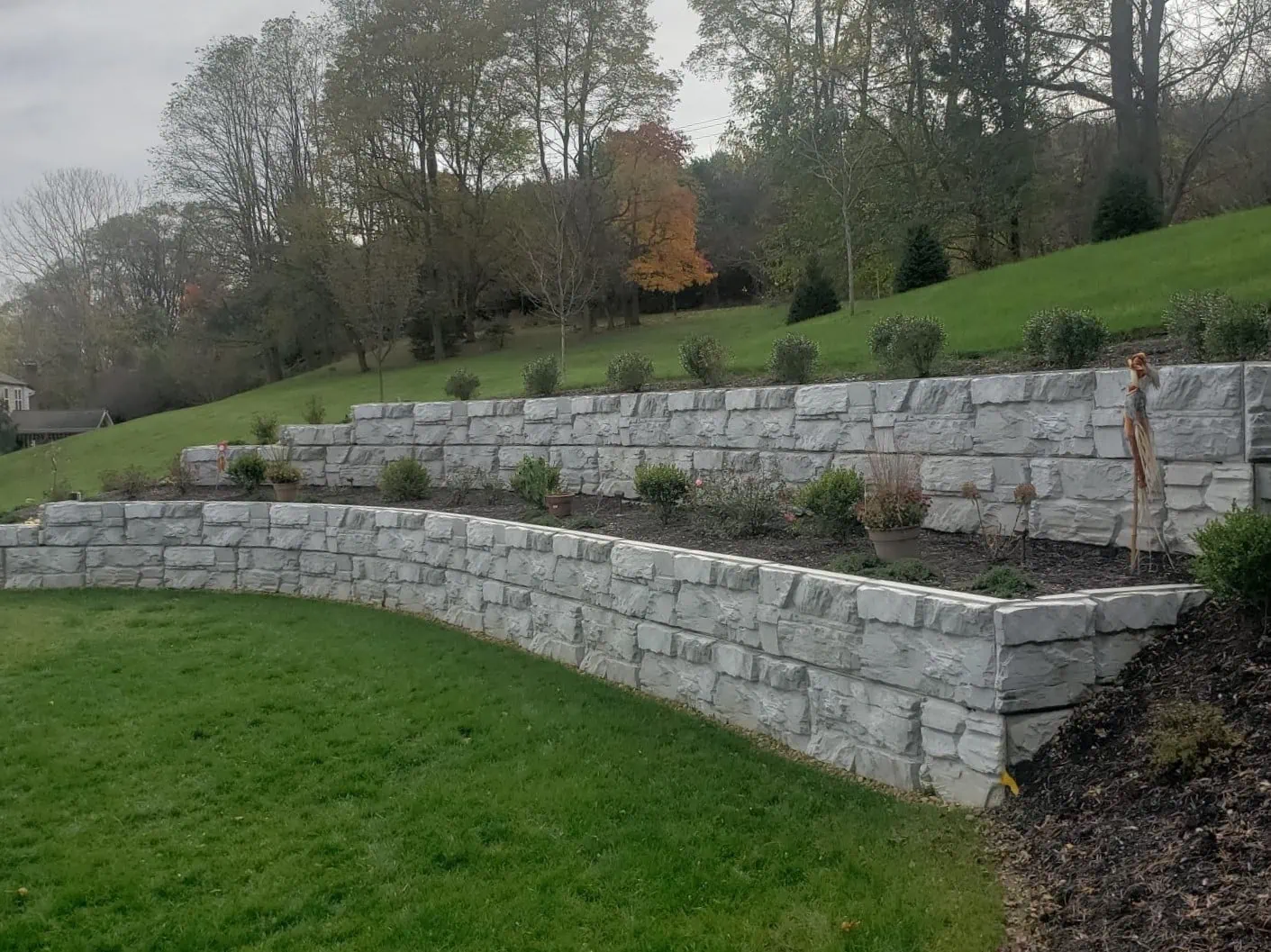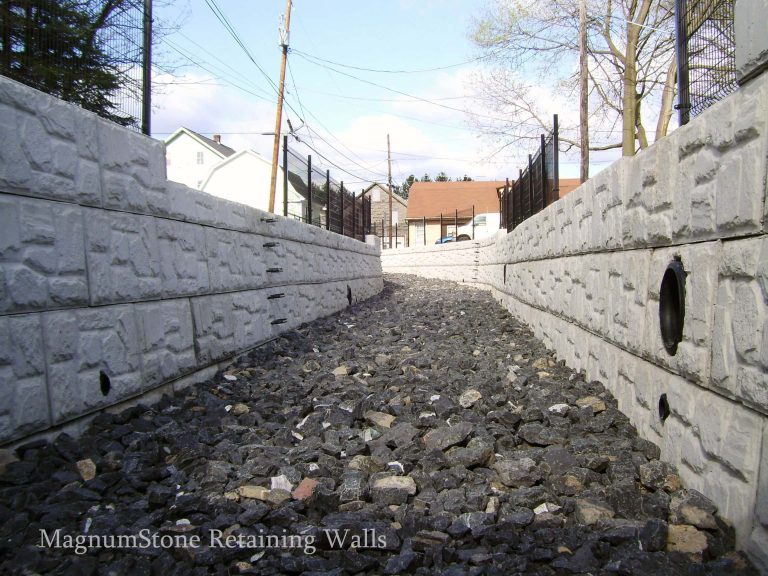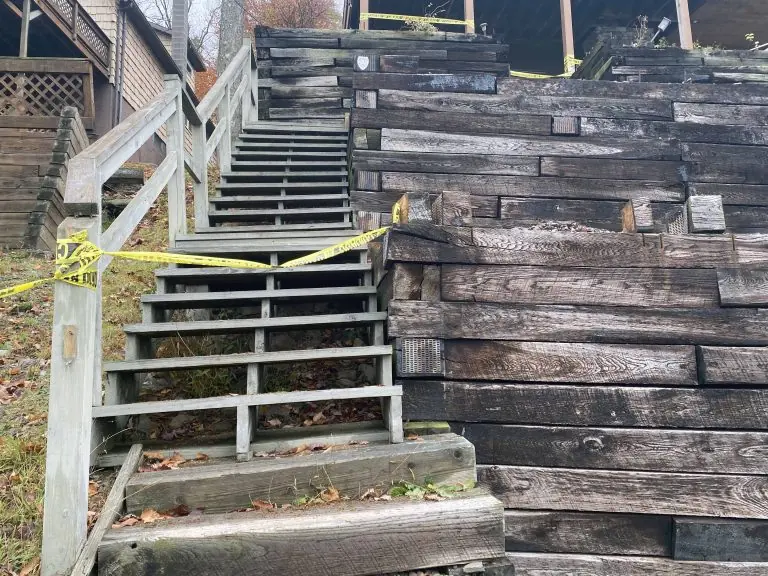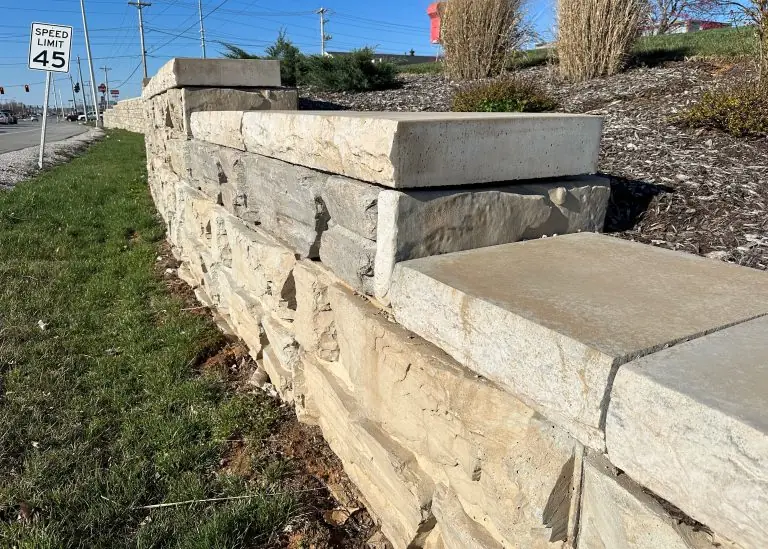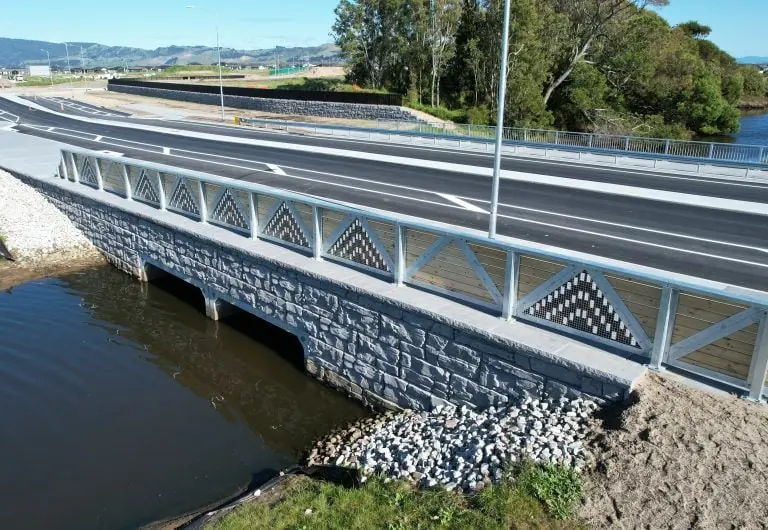How MagnumStone Retaining Walls Outperform Wood Railroad Ties
The construction of retaining walls has become a necessary component of most residential properties and commercial developments. That’s why using proper materials to install newly built retaining walls or perform repairs to ageing retaining walls is critical to a property’s safety and structural integrity. When choosing these materials, uncompromising strength and long-lasting durability must be top of mind.
There’s few worse or more dangerous scenarios than a retaining wall that quickly deteriorates or fails soon after completion. Retaining walls are valuable investments for landowners, a primary reason why homeowners, developers and designers shy away from building them with wooden railroad ties. From structural and safety standpoints, constructing retaining walls with precast engineered big blocks like MagnumStone are preferred due to the system’s resiliency, versatility and proven capabilities.
Let’s examine some big questions and considerations when planning and building retaining walls with concrete blocks compared to railroad ties:
- What is a railroad tie retaining wall?
- How do wood railroad ties differ from engineered concrete block walls?
- Issues and challenges of railroad tie retaining walls
- The advantages of concrete block retaining walls
- Cost considerations of precast blocks vs. railroad ties
- Environmental Impacts
What is a Railroad Tie Retaining Wall?
Wooden railroad ties got their name as a common material to build and support railway tracks. Dating back over a century, long and heavy pieces of wood, typically timber, were held together by metal spikes to assemble railroads. They would soon be repurposed for other uses, such as building makeshift retaining walls.
The concept and process of building wooden railroad tracks and wooden retaining walls is extremely similar, having remained nearly unchanged over the decades. The wood is connected together and secured with large metal spikes that hold the lengths together. For retaining walls, rows of wood railroad ties are stacked atop each other and staggered to improve the retaining wall’s stability.
How long do railroad ties last for retaining walls? This largely depends on wood quality and how well it is maintained. The longevity of untreated timber walls is approximately 3 to 5 years, whereas pressure-treated chemicals can help wood ties last approximately 10 years. That said, the cost of upkeep and maintenance to ensure the walls remain in good shape requires significant time and money.
How do Wood Railroad Ties Differ from Engineered Concrete Block Walls?
Engineered concrete block retaining wall systems are now more advanced than ever. Strategically designed for specific purposes, heights, loads and pressures, concrete block walls have benefitted from modern innovation to reinforce soil with a calculated design to provide maximum strength and safety.
Block retaining walls have a far longer lifespan and are capable of holding back more soil and tension than their wooden counterparts. They also deliver a more secure solution for taller and more sophisticated applications. Though the price tag of precast concrete blocks is initially higher, the future maintenance and repairs of wood railroad ties can conceivably cost as much – or more – in the long run.
Issues and Challenges of Wood Retaining Walls
Though wood railroad tie were a primary building material for decades, there have been many concerning issues associated with their quality, longevity and disposal. The main challenges of building retaining walls with wood railroad ties include:
Wood Rotting Over Time
Water is the enemy of all retaining walls, but wood retaining walls are extra susceptible to water damage. Over extended periods of time, the wood’s exposure to moisture leads to increased saturation and swelling which weakens its structure and strength. Further compounded by water damage, fungus growth atop and throughout the wall gradually breaks down the wood and causes rapid deterioration.
Similar to buildings and housing structures, insects can wreak havoc on wood railroad ties. Termites and carpenter ants can destroy the wood from the inside out, often leading to irreparable damage and the quick decay of wood railroad tie retaining walls.
Instability of Wood Materials
In general, wood is a vulnerable material that is prone to warp and splinter, which is usually caused by weather or natural causes beyond a landowner’s control. Daily and prolonged seasonal challenges like rainy climates and freeze thaw cycles can play a role in shifting movements which wood walls aren’t built to compensate for. This results in considerable repairs or a weakened, unstable wooden structure.
Use of Harmful Chemicals to Preserve Ties
Studies have revealed alarming health and environmental issues connected to creosote, a highly popular chemical treatment for wood railroad ties. The intent of this chemical is to prevent decay and extend the lifespan of wood ties, however harmful effects can spread well beyond preserving wood. Creosote exposure could range from rashes and skin irritation to increased risk of cancer and respiratory issues.
The Environmental Protection Agency (EPA) has identified creosote as a hazardous waste and the chemical is banned for residential uses such as gardening and landscaping in the United States. It’s strongly recommended to avoid use of creosote treated wood around children’s play areas. Creosote treated railroad ties should be handled and disposed of with care, wearing gloves and long sleeve shirts.
Weight and Load Limitations
Site conditions always vary for each project, whether the retaining wall is relatively small like a raised garden or a larger wall to withstand active loads and structures behind the wall. Immense weight, pressures and loading from behind the wall are not ideal for railroad tie retaining walls.
The advanced reinforcement of precast concrete blocks is more adept at handling extreme pressures and active loading. MagnumStone blocks are capable of securing geogrid with proven test data that is performed in a lab and used for analysis with complex design programs or interlocking gravity extender units to achieve the necessary strength and mass to construct any size retaining wall.
The Advantages of Concrete Block Retaining Walls
The benefits of concrete block retaining wall systems have become more apparent over the years as modern applications and design considerations evolved. This ranges from hollow core block designs that cater to contractors and installation crews, to multi-length gravity extender units for tall, complex gravity walls.
Precast big block walls now offer increasingly strong, efficient and trusted retaining wall solutions:
Long-Lasting Durability of Precast Concrete
The composition of wet-cast precast concrete delivers superior, everlasting block durability compared to wood retaining wall materials. Contrary to cast-in-place concrete, precast concrete greatly benefits from its controlled production process.
The use of tools and vibration tables are able to remove excess air bubbles from the wet-cast concrete to minimize areas water can cause damage. Automation and precise curing procedures give the blocks optimal conditions for meticulous quality control. This allows the blocks to fully hydrate and solidify, maximizing their strength. That repetitive production process yields consistent, high-quality retaining wall blocks.
Precast Concrete’s Water and Insect Resistance
Water is the well-known nemesis of retaining walls. To counteract its effects, the controlled production of precast blocks results in concrete with extremely low absorption levels. With minimal cracks and crevasses for water to infiltrate, blocks are more weather-resistant and can withstand exposure to lakes, rivers and oceans, including freshwater, saltwater and brackish water conditions.
The block design of precast retaining wall systems like MagnumStone go a step further to generate safer, more efficient drainage. MagnumStone’s hollow core blocks are filled with clear crush drainage gravel to empower permeability, filtering out sediment and debris from runoff in the process to help prevent clogged drainage channels. The gravel replenishes the block’s mass for extra strength too.
As an added bonus, termites and carpenter ants aren’t inclined to eat and destroy concrete.
Ease of Installation and Minimal Maintenance
When it comes to the construction of precast retaining walls, most big block systems are fast and easy to install. Gone are the days of labor-intensive retaining wall builds, these interlocking big blocks are lifted into place and backfill materials are moved with machinery as needed.
With MagnumStone’s interlocking units, SecureLugs on the bottom of standard blocks seamlessly fit into the top of blocks below. The blocks’ built-in SecureLugs provide a consistent setback, alignment and superior connection. Since MagnumStone hollow core blocks use 40% less concrete than solid block systems, they can quickly be installed with mini excavators or smaller skid steer loaders, and installation crews of as few as 2 or 3 people.
As long as drainage outlets direct water away from the base of the wall, precast walls require minimal (if any) maintenance. Manufactured stains can also be applied after construction to give the wall different color effects. These blocks are super easy to maintain, so landowners have less to worry about.
Versatile Design Options and Different Block Sizes
The wealth of creative design options offered by precast blocks can be catered to the size, complexity and features that landowners and developers wish to build. Precast wall solutions aren’t limited to gravity designs like wood railroad ties. Geogrid and steel reinforcement equip precast blocks with further strength and support for bridges, large commercial developments and more.
The design of different block systems can play a factor too. MagnumStone’s blocks are designed with an angled side to make planning and installing beautiful curves easier. Their gravity extenders can also be layered to fortify outside corners, a traditional weak spot of most retaining walls due to high pressure. MagnumStone’s standard blocks cover 8 sq. ft. (0.74 sq. m.) of facing at a time, complemented by a product line that includes half-high blocks and half-wide blocks for extra design flexibility.
Cost Considerations of Precast Blocks vs. Railroad Ties
When it comes to long-standing structures, the strongest and most dependable materials will of course have a higher price tag to buy and install. As such, the cost comparison of concrete blocks vs. wooden railroad ties will show that wood materials are cheaper – but over time can that be misleading?
Through the lens of longevity, let’s assess maintenance of one retaining wall built with precast concrete blocks compared to a wooden retaining wall. This is where the low maintenance of precast blocks, their ability to weather the elements and stand for decades are worthwhile. Railroad ties on the other hand, may need to be replaced every decade. Over time, the nickels and dimes repairing and maintaining the ties, in tandem with replacing rotten wood, are costs that must be considered and anticipated.
Another factor to ponder is the damage an unmaintained wood tie retaining wall could cause, since its purpose is to protect land above and below the wall. Will the property owner treat, repair and maintain the wood ties appropriately? What’s at stake above and below the wall if not? A properly designed and installed precast block retaining wall gives landowners ‘set it and forget it’ peace of mind.
Environmental Impacts
The importance of sustainable building materials is important when considering the long-term viability and effects of developments and their retaining walls. Like any building material, railroad ties and concrete blocks both have considerations that should be accounted for.
Precast concrete requires natural resources and water throughout its production process, however precast systems like MagnumStone are working to reduce their environmental footprint and carbon emissions in tangible ways. This is evident with MagnumStone’s hollow core block designs that use 40% less concrete than solid block systems and creative plantable walls that reduce heat island effects. These blocks are meant to serve as long-term solutions for complex soil retention and development projects. Upon the end of its lifespan, precast concrete can also be recycled for other uses to minimize waste.
The core environmental concerns with railroad ties center around deforestation and the harmful chemicals used to treat and conserve the wood, making them tough to maintain and get rid of. It is recommended to check with local municipal regulations and guidelines about the disposal of railroad ties, as this can be a complicated process. Due to their hazardous components, treated wood ties should not be burned and may not be accepted at landfills. In some cases they must be disposed of by a licensed contractor.
Left to decompose on their own, the creosote components of wood ties can contaminate soils which then effect existing or future gardens, plants and water sources in the process. With railroad ties’ short lifespans, the wood must be treated frequently, then repeatedly replaced and safely disposed of when the wood is no longer feasible for retaining wall uses.
This MagnumStone case study highlights the benefits of precast retaining wall blocks compared to aging wooden railroad ties. The numerous advantages of concrete blocks, including superior strength, durability and structural design versatility offer exceptional upside compared to the limitations and maintenance of wood railroad tie retaining walls. Eager to begin planning your retaining wall? Download our MagnumStone Retaining Wall Design & Analysis Software today for wall solutions and everlasting protection of residential, commercial and infrastructure projects.
Photos: Masters Concrete Products, Cirtex, York Building Products and TJR Concrete.

